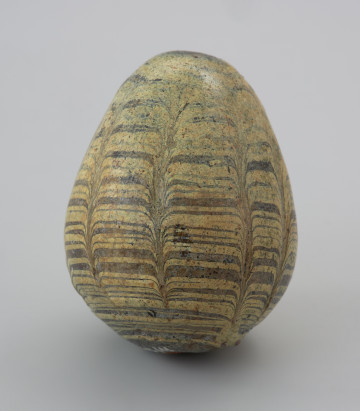
Figurine - ancestor
National Museum in Szczecin
Part of the collection: Middle Ages
A wooden figurine of a horse was found during archaeological excavations in the Old Town in Wolin, near the church of St. Wojciech and St. George, without any context allowing for more precise dating. It is a simplified image of a horse with a small head, pointed ears, a long neck and a disproportionately short body and schematically marked leg, carved from a flat piece of wood no more than one centimetre thick. Initially, the Wolin figurine was considered a child's toy, damaged during planing or even a board game gaming counter. However, the matter of interpretation of such finds is more complicated. The most often stressed is the connection of these small objects with the cult and ritual sphere of life. At present, finds of zoomorphic figurines from the 10th-12th centuries are rarely identified with children's games and toys. Their connection with the unique role of horses in spiritual culture in the early Middle Ages in the Slavic, Baltic and Scandinavian areas around the Baltic is often emphasised. The horse had many symbolic meanings; it was considered an intermediary between the spheres of the sacrum and profanum. Thietmar, a German bishop and chronicler, wrote in his chronicle in the 11th century that members of the Redar tribe of Radegost venerated the horse as the greatest saint. Sources have preserved records of rituals performed with horses. The Slavs from Szczecin had the custom of leading a saddled sacred horse through spears laid on the ground. In this way, they foretold good or bad luck in military expeditions. Touching the spear was a bad omen. According to Herbord, the Szczecin horse was big, fat, black and very wild. It was not allowed to be ridden or used for work. It was looked after daily by one of the four high priests. Material sources also testify to the extraordinary importance of the horse in the early Middle Ages. As the so-called foundation offerings, horse skulls were placed under the foundations of residential houses and public buildings, e.g. ramparts and temples. There are also known cases of placing horse heads over gates leading to the interiors of fortified settlements and horse burials within early medieval cemeteries.
Anna Bogumiła Kowalska
Author / creator
Dimensions
cały obiekt: height: 8.5 cm, width: 5.7 cm
Object type
cult object, figurine
Technique
hand made, individual
Material
wood
Creation / finding place
Owner
Muzeum Narodowe w Szczecinie
Identification number
Location / status

National Museum in Szczecin

1100 — 1200
National Museum in Szczecin

National Museum in Szczecin
DISCOVER this TOPIC
Castle Museum in Łańcut
DISCOVER this PATH
Educational path